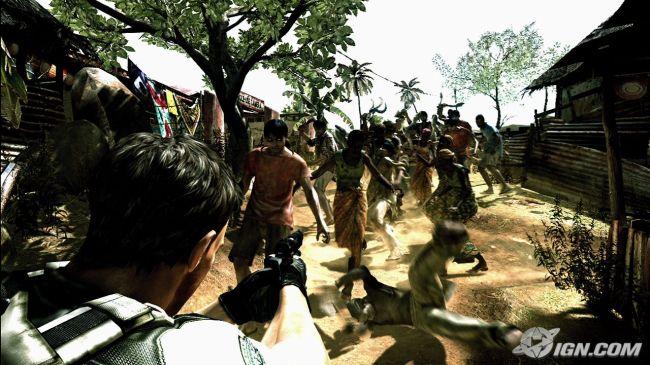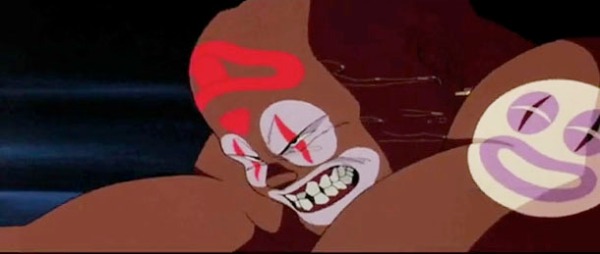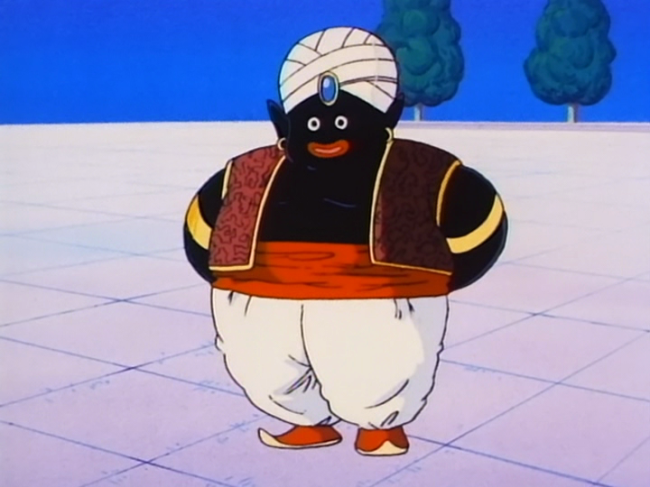Recently, National Public Radio (1) referenced work by Polygon (2) on the history of Street Fighter II and its alleged flagrant racism. The article touches on the company’s use of ethnic, cultural, and national stereotypical (some may argue iconic) imagery as the basis of its world spanning roster of fighters: the burly Russian wrestler who fights bears (Zangief), to the Sumo Wrestler E. Honda, to camo clad American Soldier Guile, to the not-so-subtle nods to Mike Tyson (M. Bison in Japan; renamed Balrog in the U.S.) and Bruce Lee (Fei Long). NPR has fostered a discussion on its website regarding the merits of the games biases and stereotypes, and the commentary reminded me of another game by published Capcom that sparked some controversy a few years back: Resident Evil 5.
The Resident Evil series is popularly known for its movies starring Milla Jovovich, which have little in common with much of the game series aside from early nods to setting (Raccoon City), enemies (zombies, Albert Wesker, Nemesis), and some characters (Jill Valentine), etc. But much of it are merely nods to the lore of the video games or even just borrowed names – the movies are beginning to match the number of games in the series, but they are wildly divergent in scope and tone. For myself, I was never much into the Resident Evil games because I detested the camera and tank like controls that made moving through the world and seeing what you were fighting a frustrating experience. Much of that changed with the advent of Resident Evil 4 – suddenly you weren’t fighting mindless zombies, but inhabitants of a sleepy Spanish hamlet that fought intelligently, communicating with one another and swarming you for multiple angles – zombies typically don’t put up knocked down ladders or leap across rooftops to cut off your escape. For a series that was wearing thin on the premise of George Romero’s shambling undead, it was a unique change of pace that moved the game out of plodding, nail biting “survival horror” and more into the realm of a survival-action shooter.
But these weren’t the only changes for the series – yes, Resident Evil 4 would take players to Europe and introduce new elements to the series in terms of a new, mind controlling parasite, but it’s much anticipated sequel pushed the franchise in new directions: Africa.
In the broadest terms, the protagonists of RE 5 are sent to Africa as part of a new taskforce responding to changes in the game world in the wake of the Umbrella Corporation (the villainous entity behind much of the world’s zombie troubles) and the events of RE 4 which saw another teammate rescuing the president’s daughter from kidnappers and the aforementioned parasites in Spain. The BSAA (Biosecurity Assessment Alliance) sends your team to Kijuju, Africa to track down stolen and/or missing technology that could be used to create a biological agent for sale on the black market. In development since at least 2005 and released in 2009, RE 5’s narrative of stolen weapons grade material in peril draws certain allusions to the War on Terror and the Collapse of the Soviet Union – missing weapons grade nuclear material, biological agents and “Weapons of Mass Destruction” were of grave concern to the world at large. But it’s hard to focus on the plot of a series notorious for its incomprehensibility when you are sent to a fictional country named, of all things, Kijuju.
Credit goes to Capcom for not simply placing the setting in Africa (not-a-country), but it goes out the window when they choose to name their fictional local Kijuju. Immediately, it evokes imagery of witch doctors and “bad ju-ju” – racial and cultural stereotyping that seems out of place with the seriousness that Capcom purports. Coupled with the use of the phrase “majini” – said to be Swahili for ‘bad spirit’ similar to the Japanese word majin – for the setting’s parasite infested inhabitants, the premise of the game bodes ill for the commentary it attempts to make on colonialism and exploitation of native groups.
Early press for the game was less than ideal (3): concerns were voiced of a white man shooting out a village full of African “others” – they are dangerous, inhuman. Imagery of cleaver and sickle wielding villagers, slavering and wild eyed, is prominent in early footage (4).

If that wasn’t enough, consider an entire sequence set in a rural village – arguably, the space contains diary journals written before the villagers were infected with the mysterious ‘plagas’ parasite: the premise is that an outside organization came to the village, offering vaccination and other medical treatment – but that instead of inoculating the villagers from an unnamed illness, the journals scattered throughout the village tell a different story. Slowly, the elders of the village became easily irritable, then paranoid, until finally dressing and adopting traditional garments and ceremonial regalia as fear grew and eventually chaos reigned. While early portions of the game are reminiscent of the squalor of Somalia and Mogadishu (see: Black Hawk Down), these rural areas are simply killing grounds for the white protagonist where dark skinned “zombies” wait in grass skirts and wooden masks, fodder for the player to mow down before progressing further into the game (5). These aren’t people in a village with actual lives, but monsters to be defeated.

It’s hard to say if the producers of Resident Evil 5 were tacitly aware of the racially charged overtones of the game in the same way that Westerners (and particularly Americans) would be, given that they have struggled with such discrimination and bigotry in different ways than Japan has. Japanese culture itself has its own struggles with racial identity (7) – its relationship to the West and mainland Asia could fill volumes on its own – but in the context of this article we will focus on media portrayals of foreigners, particularly those seen as racial minorities.

Many protagonists in anime are nominally Asian (and often Caucasian), but the ranks of secondary characters, villains, and minor background parts are filled with stereotypical minorities – often with Afros, exaggerated facial features, or other trappings of the blaxiploitation era. But knowing how culture, particularly American Popular Culture, has been and often still is commoditized in Japan and elsewhere for its exotic novelty and freshness, it becomes hard to say that Resident Evil 5 is knowingly and willfully bigoted towards Africa and Africans. It’s one thing to attack American media for portraying Africa as a “Dark Continent” full of dangerous natives and terrors in the jungle, but it’s another to place that same level of awareness on a culture that has been exposed to second and third hand experiences of another cultures, frequently divorced of the implications and context of the environment it was created in. If anything, I would draw the conclusion that Japan has instead shown us a dark reflection of our own cultures: one that struggles with a legacy of racism and imperialism to this day. This isn’t an absolution of a Japanese video game made, at times, in poor taste, but it is a call to stop demonizing artists out of hand when they casually play with elements they’re not as familiar with as we are.
— Sources —
(1) The Original NPR Story
www.npr.org/blogs/codeswitch/2014/03/16/290119728/street-fighter-ii-most-racist-nostalgic-video-game-ever
(2) The Polygon Article
http://www.polygon.com/a/street-fighter-2-oral-history
(3) Press Commentary
http://multiplayerblog.mtv.com/2008/04/10/newsweeks-ngai-croal-on-the-resident-evil-5-trailer-this-imagery-has-a-history/
(4) Early Footage
http://www.youtube.com/watch?v=EpIWhAAiNRc
(5) Resident Evil 5: “The Marsh, The Village and the Oil Refinery”
https://www.youtube.com/watch?v=0aDJBYxphnE
https://www.youtube.com/watch?v=KcAdZRit7AY
https://www.youtube.com/watch?v=9AwKbB_wNyw
(6) Blackface
http://en.wikipedia.org/wiki/Blackface
Blaxploitation
http://en.wikipedia.org/wiki/Blaxploitation
(7) Is Japan a “homogenous” nation?
http://japanfocus.org/-chris-burgess/3310
March 16, 2014 | Categories: Anecdotal, Cross Cultural, Japan, Popular Culture, Racism, Uncategorized, Video Games | Tags: 4, 5, africa, african, analysis, Anthropology, bigotry, biohazard, cold war, Colonialism, culture, evil, Japan, japanese, kijuju, majin, nemesis, not-a-country, NPR, plagas, popular, racism, resident, social commentary, street fighter II, swahili, video games, wesker, wmd, zombies | Leave a comment


Resident Racism: Colonialism and Ham Fisted Advocacy in Resident Evil 5
Recently, National Public Radio (1) referenced work by Polygon (2) on the history of Street Fighter II and its alleged flagrant racism. The article touches on the company’s use of ethnic, cultural, and national stereotypical (some may argue iconic) imagery as the basis of its world spanning roster of fighters: the burly Russian wrestler who fights bears (Zangief), to the Sumo Wrestler E. Honda, to camo clad American Soldier Guile, to the not-so-subtle nods to Mike Tyson (M. Bison in Japan; renamed Balrog in the U.S.) and Bruce Lee (Fei Long). NPR has fostered a discussion on its website regarding the merits of the games biases and stereotypes, and the commentary reminded me of another game by published Capcom that sparked some controversy a few years back: Resident Evil 5.
The Resident Evil series is popularly known for its movies starring Milla Jovovich, which have little in common with much of the game series aside from early nods to setting (Raccoon City), enemies (zombies, Albert Wesker, Nemesis), and some characters (Jill Valentine), etc. But much of it are merely nods to the lore of the video games or even just borrowed names – the movies are beginning to match the number of games in the series, but they are wildly divergent in scope and tone. For myself, I was never much into the Resident Evil games because I detested the camera and tank like controls that made moving through the world and seeing what you were fighting a frustrating experience. Much of that changed with the advent of Resident Evil 4 – suddenly you weren’t fighting mindless zombies, but inhabitants of a sleepy Spanish hamlet that fought intelligently, communicating with one another and swarming you for multiple angles – zombies typically don’t put up knocked down ladders or leap across rooftops to cut off your escape. For a series that was wearing thin on the premise of George Romero’s shambling undead, it was a unique change of pace that moved the game out of plodding, nail biting “survival horror” and more into the realm of a survival-action shooter.
But these weren’t the only changes for the series – yes, Resident Evil 4 would take players to Europe and introduce new elements to the series in terms of a new, mind controlling parasite, but it’s much anticipated sequel pushed the franchise in new directions: Africa.
In the broadest terms, the protagonists of RE 5 are sent to Africa as part of a new taskforce responding to changes in the game world in the wake of the Umbrella Corporation (the villainous entity behind much of the world’s zombie troubles) and the events of RE 4 which saw another teammate rescuing the president’s daughter from kidnappers and the aforementioned parasites in Spain. The BSAA (Biosecurity Assessment Alliance) sends your team to Kijuju, Africa to track down stolen and/or missing technology that could be used to create a biological agent for sale on the black market. In development since at least 2005 and released in 2009, RE 5’s narrative of stolen weapons grade material in peril draws certain allusions to the War on Terror and the Collapse of the Soviet Union – missing weapons grade nuclear material, biological agents and “Weapons of Mass Destruction” were of grave concern to the world at large. But it’s hard to focus on the plot of a series notorious for its incomprehensibility when you are sent to a fictional country named, of all things, Kijuju.
Credit goes to Capcom for not simply placing the setting in Africa (not-a-country), but it goes out the window when they choose to name their fictional local Kijuju. Immediately, it evokes imagery of witch doctors and “bad ju-ju” – racial and cultural stereotyping that seems out of place with the seriousness that Capcom purports. Coupled with the use of the phrase “majini” – said to be Swahili for ‘bad spirit’ similar to the Japanese word majin – for the setting’s parasite infested inhabitants, the premise of the game bodes ill for the commentary it attempts to make on colonialism and exploitation of native groups.
Early press for the game was less than ideal (3): concerns were voiced of a white man shooting out a village full of African “others” – they are dangerous, inhuman. Imagery of cleaver and sickle wielding villagers, slavering and wild eyed, is prominent in early footage (4).
If that wasn’t enough, consider an entire sequence set in a rural village – arguably, the space contains diary journals written before the villagers were infected with the mysterious ‘plagas’ parasite: the premise is that an outside organization came to the village, offering vaccination and other medical treatment – but that instead of inoculating the villagers from an unnamed illness, the journals scattered throughout the village tell a different story. Slowly, the elders of the village became easily irritable, then paranoid, until finally dressing and adopting traditional garments and ceremonial regalia as fear grew and eventually chaos reigned. While early portions of the game are reminiscent of the squalor of Somalia and Mogadishu (see: Black Hawk Down), these rural areas are simply killing grounds for the white protagonist where dark skinned “zombies” wait in grass skirts and wooden masks, fodder for the player to mow down before progressing further into the game (5). These aren’t people in a village with actual lives, but monsters to be defeated.
It’s hard to say if the producers of Resident Evil 5 were tacitly aware of the racially charged overtones of the game in the same way that Westerners (and particularly Americans) would be, given that they have struggled with such discrimination and bigotry in different ways than Japan has. Japanese culture itself has its own struggles with racial identity (7) – its relationship to the West and mainland Asia could fill volumes on its own – but in the context of this article we will focus on media portrayals of foreigners, particularly those seen as racial minorities.
Many protagonists in anime are nominally Asian (and often Caucasian), but the ranks of secondary characters, villains, and minor background parts are filled with stereotypical minorities – often with Afros, exaggerated facial features, or other trappings of the blaxiploitation era. But knowing how culture, particularly American Popular Culture, has been and often still is commoditized in Japan and elsewhere for its exotic novelty and freshness, it becomes hard to say that Resident Evil 5 is knowingly and willfully bigoted towards Africa and Africans. It’s one thing to attack American media for portraying Africa as a “Dark Continent” full of dangerous natives and terrors in the jungle, but it’s another to place that same level of awareness on a culture that has been exposed to second and third hand experiences of another cultures, frequently divorced of the implications and context of the environment it was created in. If anything, I would draw the conclusion that Japan has instead shown us a dark reflection of our own cultures: one that struggles with a legacy of racism and imperialism to this day. This isn’t an absolution of a Japanese video game made, at times, in poor taste, but it is a call to stop demonizing artists out of hand when they casually play with elements they’re not as familiar with as we are.
— Sources —
(1) The Original NPR Story
www.npr.org/blogs/codeswitch/2014/03/16/290119728/street-fighter-ii-most-racist-nostalgic-video-game-ever
(2) The Polygon Article
http://www.polygon.com/a/street-fighter-2-oral-history
(3) Press Commentary
http://multiplayerblog.mtv.com/2008/04/10/newsweeks-ngai-croal-on-the-resident-evil-5-trailer-this-imagery-has-a-history/
(4) Early Footage
http://www.youtube.com/watch?v=EpIWhAAiNRc
(5) Resident Evil 5: “The Marsh, The Village and the Oil Refinery”
https://www.youtube.com/watch?v=0aDJBYxphnE
https://www.youtube.com/watch?v=KcAdZRit7AY
https://www.youtube.com/watch?v=9AwKbB_wNyw
(6) Blackface
http://en.wikipedia.org/wiki/Blackface
Blaxploitation
http://en.wikipedia.org/wiki/Blaxploitation
(7) Is Japan a “homogenous” nation?
http://japanfocus.org/-chris-burgess/3310
March 16, 2014 | Categories: Anecdotal, Cross Cultural, Japan, Popular Culture, Racism, Uncategorized, Video Games | Tags: 4, 5, africa, african, analysis, Anthropology, bigotry, biohazard, cold war, Colonialism, culture, evil, Japan, japanese, kijuju, majin, nemesis, not-a-country, NPR, plagas, popular, racism, resident, social commentary, street fighter II, swahili, video games, wesker, wmd, zombies | Leave a comment